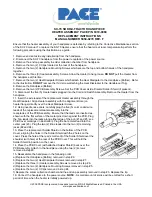
®
Technical Support
PS
-
3201
7
013-14647C
Theory of Calibration
One of the functions of the PASCO Data Collection
Software is to take the stream of raw data from a sensor
and transform it into the calibrated data that you see in
the Graph, Table, and other displays. If you do not
calibrate a sensor yourself, the software uses a default
calibration that is loaded when the sensor is connected.
You can think of the software as taking in raw data and
outputing calibrated data. When you perform a
calibration, the software redefines the linear equation
that transforms the raw input data into the calibrated
output data. The linear function is of the form:
Raw Input = Slope x Calibrated Offset
Or:
Calibrated Output = (Raw Input - Offset)/Slope
The function can be represented graphically as a line.
Two points, Pt 1 and Pt 2, define the line. In the
two-point calibration procedure, each point is reset by
associating a known standard value (for instance, the
temperature of ice water) with a raw input measurement
that the sensor sends out when it is in that standard. In a
one-point calibration, only one of the points is reset by
the user.
Types of Calibration
There are three types of calibration: two-point, one-point
slope, and one-point offset. Any of these calibrations can
be performed on a single sensor, or simultaneously on
multiple similar sensors; however, for any given sensor,
the software will automatically select the most typical
calibration type as the default setting.
Two-Point
In a two-point calibration, you reset two points to define
a new line. This type of calibration affects both the slope
and the offset.
One-Point Slope
In a one-point slope calibration, you reset only one point.
The slope of the line changes so that the line intersects
the new point, while the offset (or Y-intercept) does not
change.
One-Point Offset
In a one-point offset calibration, you reset only one point.
The line shifts so that it intersects the new point, but its
slope does not change.
Offset calibration is usually used to make one sensor
agree with another sensor. Due to normal variation
among probes, a second probe might read consistently
higher than the first probe. Normally this difference
would be insignificant; however, an offset calibration can
be used to bring the sensors into closer alignment.


























